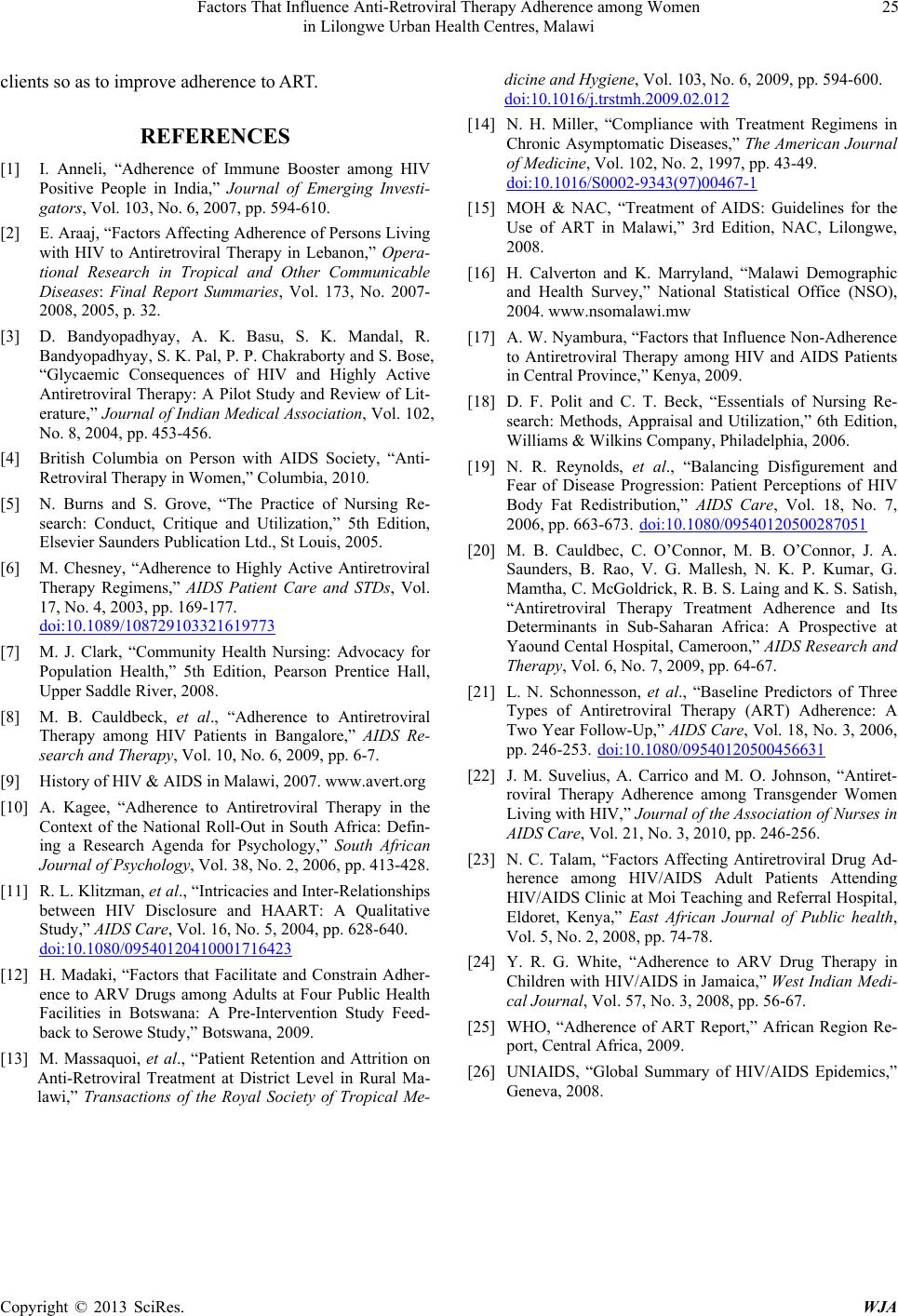
Factors That Influence Anti-Retroviral Therapy Adherence among Women
in Lilongwe Urban Health Centres, Malawi
25
clients so as to improve adherence to ART.
REFERENCES
[1] I. Anneli, “Adherence of Immune Booster among HIV
Positive People in India,” Journal of Emerging Investi-
gators, Vol. 103, No. 6, 2007, pp. 594-610.
[2] E. Araaj, “Factors Affecting Adherence of Persons Living
with HIV to Antiretroviral Therapy in Lebanon,” Opera-
tional Research in Tropical and Other Communicable
Diseases: Final Report Summaries, Vol. 173, No. 2007-
2008, 2005, p. 32.
[3] D. Bandyopadhyay, A. K. Basu, S. K. Mandal, R.
Bandyopadhyay, S. K. Pal, P. P. Chakraborty and S. Bose,
“Glycaemic Consequences of HIV and Highly Active
Antiretroviral Therapy: A Pilot Study and Review of Lit-
erature,” Journal of Indian Medical Association, Vol. 102,
No. 8, 2004, pp. 453-456.
[4] British Columbia on Person with AIDS Society, “Anti-
Retroviral Therapy in Women,” Columbia, 2010.
[5] N. Burns and S. Grove, “The Practice of Nursing Re-
search: Conduct, Critique and Utilization,” 5th Edition,
Elsevier Saunders Publication Ltd., St Louis, 2005.
[6] M. Chesney, “Adherence to Highly Active Antiretroviral
Therapy Regimens,” AIDS Patient Care and STDs, Vol.
17, No. 4, 2003, pp. 169-177.
doi:10.1089/108729103321619773
[7] M. J. Clark, “Community Health Nursing: Advocacy for
Population Health,” 5th Edition, Pearson Prentice Hall,
Upper Saddle River, 2008.
[8] M. B. Cauldbeck, et al., “Adherence to Antiretroviral
Therapy among HIV Patients in Bangalore,” AIDS Re-
search and Therapy, Vol. 10, No. 6, 2009, pp. 6-7.
[9] History of HIV & AIDS in Malawi, 2007. www.avert.org
[10] A. Kagee, “Adherence to Antiretroviral Therapy in the
Context of the National Roll-Out in South Africa: Defin-
ing a Research Agenda for Psychology,” South African
Journal of Psychology, Vol. 38, No. 2, 2006, pp. 413-428.
[11] R. L. Klitzman, et al., “Intricacies and Inter-Relationships
between HIV Disclosure and HAART: A Qualitative
Study,” AIDS Care, Vol. 16, No. 5, 2004, pp. 628-640.
doi:10.1080/09540120410001716423
[12] H. Madaki, “Factors that Facilitate and Constrain Adher-
ence to ARV Drugs among Adults at Four Public Health
Facilities in Botswana: A Pre-Intervention Study Feed-
back to Serowe Study,” Botswana, 2009.
[13] M. Massaquoi, et al., “Patient Retention and Attrition on
Anti-Retroviral Treatment at District Level in Rural Ma-
lawi,” Transactions of the Royal Society of Tropical Me-
dicine and Hygiene, Vol. 103, No. 6, 2009, pp. 594-600.
doi:10.1016/j.trstmh.2009.02.012
[14] N. H. Miller, “Compliance with Treatment Regimens in
Chronic Asymptomatic Diseases,” The American Journal
of Medicine, Vol. 102, No. 2, 1997, pp. 43-49.
doi:10.1016/S0002-9343(97)00467-1
[15] MOH & NAC, “Treatment of AIDS: Guidelines for the
Use of ART in Malawi,” 3rd Edition, NAC, Lilongwe,
2008.
[16] H. Calverton and K. Marryland, “Malawi Demographic
and Health Survey,” National Statistical Office (NSO),
2004. www.nsomalawi.mw
[17] A. W. Nyambura, “Factors that Influence Non-Adherence
to Antiretroviral Therapy among HIV and AIDS Patients
in Central Province,” Kenya, 2009.
[18] D. F. Polit and C. T. Beck, “Essentials of Nursing Re-
search: Methods, Appraisal and Utilization,” 6th Edition,
Williams & Wilkins Company, Philadelphia, 2006.
[19] N. R. Reynolds, et al., “Balancing Disfigurement and
Fear of Disease Progression: Patient Perceptions of HIV
Body Fat Redistribution,” AIDS Care, Vol. 18, No. 7,
2006, pp. 663-673. doi:10.1080/09540120500287051
[20] M. B. Cauldbec, C. O’Connor, M. B. O’Connor, J. A.
Saunders, B. Rao, V. G. Mallesh, N. K. P. Kumar, G.
Mamtha, C. McGoldrick, R. B. S. Laing and K. S. Satish,
“Antiretroviral Therapy Treatment Adherence and Its
Determinants in Sub-Saharan Africa: A Prospective at
Yaound Cental Hospital, Cameroon,” AIDS Research and
Therapy, Vol. 6, No. 7, 2009, pp. 64-67.
[21] L. N. Schonnesson, et al., “Baseline Predictors of Three
Types of Antiretroviral Therapy (ART) Adherence: A
Two Year Follow-Up,” AIDS Care, Vol. 18, No. 3, 2006,
pp. 246-253. doi:10.1080/09540120500456631
[22] J. M. Suvelius, A. Carrico and M. O. Johnson, “Antiret-
roviral Therapy Adherence among Transgender Women
Living with HIV,” Journal of the Association of Nurses in
AIDS Care, Vol. 21, No. 3, 2010, pp. 246-256.
[23] N. C. Talam, “Factors Affecting Antiretroviral Drug Ad-
herence among HIV/AIDS Adult Patients Attending
HIV/AIDS Clinic at Moi Teaching and Referral Hospital,
Eldoret, Kenya,” East African Journal of Public health,
Vol. 5, No. 2, 2008, pp. 74-78.
[24] Y. R. G. White, “Adherence to ARV Drug Therapy in
Children with HIV/AIDS in Jamaica,” West Indian Medi-
cal Journal, Vol. 57, No. 3, 2008, pp. 56-67.
[25] WHO, “Adherence of ART Report,” African Region Re-
port, Central Africa, 2009.
[26] UNIAIDS, “Global Summary of HIV/AIDS Epidemics,”
Geneva, 2008.
Copyright © 2013 SciRes. WJA